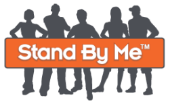Stand by Me© is a program that combats bullying by teaching bystanders how to help victims. It is, in effect, an anti-bullying club whose membership is inclusive rather than exclusive. The data gathered to date suggest that teaching students what to do when they see bullying occur results in a powerful support system school-wide. Victims feel supported, bystanders feel empowered, and bullies want to join.
STEP FORWARD

They learn how to approach and assist the victim, creating an immediate support system for targets of bullying.
STAND BACK

Students also learn when not to intervene, but to alert an adult instead.
Program Advantages
The program is simple, effective, and easy to train.
Half-day training for the faculty sponsor, who then serves as on-site trainer for your students and staff.
Half-hour training for faculty and staff.
One-hour training for students.
In both instances students record the incident, its time and location, and their response. Data is regularly given to administrators so that staff can be assigned to “hot spots” on campus.

The Students
The program is designed to be student-driven and student-led, under supervision of a faculty sponsor. The program appeals to a wide cross-section of the student body, including both general and special education students.
The Results

Students record data because students see bullying happen. Many bullying incidents in schools do not become office referrals. Our data suggest that once students are trained, there is an impressive frequency of helping interventions.
Please contact us for a proposal that meets your needs, inclusive of materials, training and ongoing support. It is adaptable for each campus. Currently in use for grades 5-8, future versions of the program will extend it to both younger and older students.

Mobilizing Bystanders
The majority of children are neither victims nor bullies, but bystanders. They fuel the bully simply by being present.
Most children are disturbed by what they see, but afraid of the consequences of action.
That inaction itself has consequences, in the feelings of powerlessness that ensue.
If they only knew what to do, how to intervene, they could make profound difference.
From Stand By Me Founder Christine Cohen:
"As a psychologist, a licensed specialist in school psychology, and as Autism Coordinator for a public school district, I have spent 24 years working with children and families, the last 17 of them specifically with children who have some form of autism spectrum disorder. Because these children do not ‘blend in’ easily, they are often the target of bullying. Because they have difficulty regulating their emotional responses, they ‘reward’ the bully by blowing up and saying inappropriate things that get them into trouble. Some examples I have heard include, ‘I’ll kill you!’, ‘I’ll blow up this school and everyone in it!’, ‘I know how to destroy you!’, ‘I’m going to pick up this chair and smash you!‘. For them, it is a way to express the intensity of their anger. For school staff, it is an incendiary statement that often results in severe disciplinary penalties.
Children with autism are truth-tellers, and the truth being told is that they are struggling to make friends, to express themselves, to do well, just like any other child; and they must do it in the context of interpreting social language and behavior that is not always friendly.
The idea for this program came from a desire to create a support system for these students, especially those in the upper elementary and middle school years, when peers are the givers of status, and adults comparatively less interesting. In schools, simplicity is everything, as training has to be continuous, and no one has time to take on additional responsibilities. In addition, teachers in grades where state testing looms large, are less willing/able to spend energy creating and maintaining social programming.
Stand by Me© is a peer led program that requires very little training. It creates an immediate support system for students being targeted by bullies, and it gives teachers and administrators important information about where and when bullying is occurring. Students define bullying differently from adults. They appear to describe that bullying in more intense terms than we would, given the same set of circumstances. They see and experience its impact in a way adults do not.
Stand by Me© began in 2007, on a middle school campus. It has continued in the years since, moving successfully into the upper elementary grades. The focus of the program as student-led has continued, and most of the problem-solving has been done by the students themselves. Their solutions are usually much better than mine.”
